HR Trends Survey 2013: Key Results
The results of the 2013 HR Trends Survey show strong similarities to the results of the 2011 and 2012 trends surveys, demonstrating continued expectations for steady or increasing revenue, a need to be flexible to operate in an environment of reorganization, restructuring and change, and a need to access talent that can manage these changes and deliver on organizational revenue targets.
Looking forward in 2013, the survey results indicate that we will see organizations:
- take steps to better understand their present and future talent needs;
- work to close critical skill and leadership gaps; and
- manage change effectively throughout the organization.
Results
Overall, projections for organization revenue growth have remained relatively consistent since 2010. In 2013 the results show 24 per cent of organizations expect no change in revenue and 52 per cent expect a slight to significant increase.
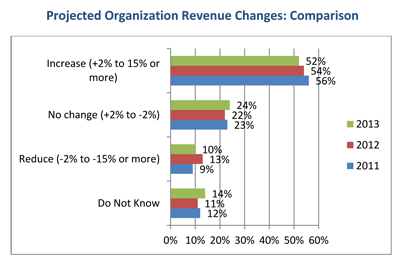
At the same time, economic uncertainty and volatility, and reduced operating budgets are among the top five challenges that will have the biggest impact on organizations in 2013. Organizations recognize that they need to be flexible to a constantly changing and challenging environment.
HR Priorities for 2013
Twenty-six per cent of HR departments added organizational restructuring to their portfolios in the last 12 months, making it the most commonly added area of responsibility for the fifth year in a row. Responsibility for strategic workforce planning has also been added to HR’s scope. This indicates that organizations recognize the need to shift, reorganize, and consciously plan to prioritize and manage top talent and staff risks in order to ensure their success in this dynamic environment.
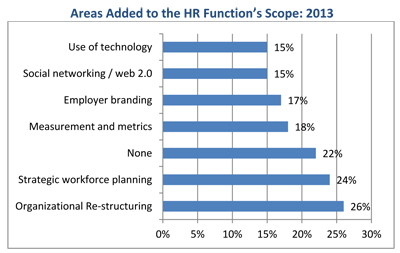
While organizations shift and restructure to help drive the revenue that they are projecting, they anticipate challenges related to organizational growth and/or contractions, and gaps between required and existing skills and leadership capability.
Managing change, maintaining an engaged workforce, and having the leadership skills to move the organization forward during such times are areas of significant importance to HR; as is the need to have the right people in the right roles now and in the future.
With rising concerns about the aging workforce, it makes sense for HR to also prioritize attracting, recruiting and planning for staff succession. This may be of particular importance in the public sector, where 18 per cent of organizations identify “retirement volumes” as the area of challenge that will have the biggest impact on their organizations in 2013 (compared to 10 per cent of organizations overall).
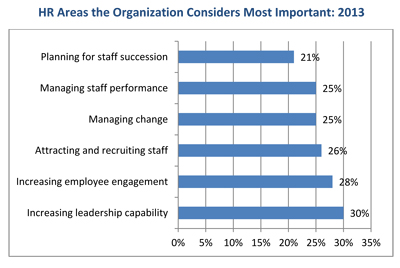
HR Investments 2013
Going hand-in-hand with staffing concerns, recruitment and selection will receive the largest increase in budget or time in 2013 (13%). This will support the 48 per cent of organizations planning to increase their workforce in 2013.
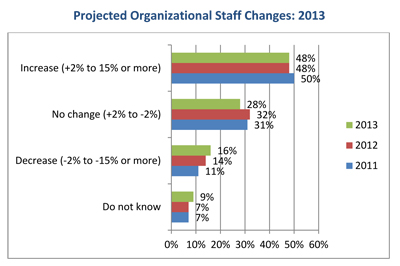
Investments of time or budget in leadership development (12%) and learning and development (9%) will help to align new staff to their roles, prepare leaders to lead change, prepare staff to successfully transition into new roles resulting from restructuring, and close the general leadership capability and skill gaps that concern HR practitioners.
In the public sector, the largest increase in investment will be in labour relations (15%).
Planning for Success
HR will play a key role in positioning organizations for success going forward, making their involvement in the development of organizational strategy important. Fifty-four per cent of HR departments are involved, engaged or drive the development of the organizational strategy, and 18 per cent are consulted during strategy development.
In addition, HR will require the ongoing support of leadership, and the financial and staff resources necessary to be successful.
HR budgets will increase in 32 per cent of organizations, stay the same in 39 per cent and reduce in 16 per cent. While this generally indicates financial support, it should be noted that in the public sector 24 per cent of organizations will see their HR budgets decline.
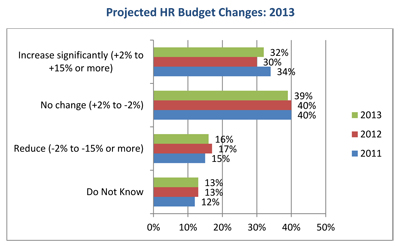
HR staffing was the number one area for HR budget reductions, with 49 per cent of organizations reporting budget reductions in this area (62 per cent in the public sector). External consulting programs and employee training and development were the next two most common areas for budget reductions.
Regardless of whether the HR budget is staying the same, growing, or decreasing, careful planning of time and resources will be required to ensure success. When faced with the demands of a high change environment, HR departments must be responsive, not reactive, to ensure that resources are used in the most effective ways possible.
Implications for HR
BC HRMA’s HR trends survey results provide valuable insight into industry trends and external conditions that will impact the strategies that your HR department uses to attract talent, prepare for change, and meet revenue targets.
Allocate Time & Resources Effectively
With results very similar to those of previous years, to effectively allocate time and resources, HR practitioners must continue to work towards the following recommendations:
- Understand the organization’s strategic direction in order to determine change requirements and support change to take place effectively;
- Understand current and potential skills related to change leadership and management, and take steps to close gaps;
- Understand the organization’s current and future workforce/leadership needs and take action to build and acquire the skills and abilities needed to move the organization forward; and
- Be open to exploring new talent pools (e.g., New Canadians) to increase access to talent and provide the organization with sources of new ideas, approaches and, potentially, business opportunities. A diversified workforce also better represents the consumer population and can have a positive impact on employer branding.
Develop HR’s Skills
HR practitioners must also take steps to close their own skill gaps. For the last several years the HR trends survey has seen a number of new areas added to the scope of the HR function, including organizational restructuring and workforce planning. With these new areas of responsibility comes the need to develop the knowledge, skills and abilities to successfully deliver on requirements. Even if consultants are used to address these organizational issues, HR requires the knowledge and skills to direct action, execute on programs/recommendations, and be the internal point of contact and recognized resource in these areas.
In addition to skill building in areas that have been added to HR’s scope, HR practitioners must also continue to build their knowledge and skills in areas of priority for 2013. Some development areas to consider include:
- Linking Activity to Strategy – Build an understanding of the organization’s strategy to determine talent requirements and increase critical thinking skills, problem solving skills, influence skills and HR strategic planning skills to drive the organization toward success.
- Recruitment & Selection – Build skills related to enhancing and communicating the employer brand; using social media and technology for recruitment and selection purposes; and skills for attracting, effectively screening, and hiring from the growing pool of immigrant talent.
- Workforce Planning & Succession Management – Build skills such as those related to identifying critical roles, understanding role requirements, and identifying high potential talent.
- Learning & Development – Build skills that will support identifying training and development needs throughout the organization, designing and implementing appropriate learning and development solutions, and measuring return on investment.
- Change Management – Build skills related to managing change processes (e.g., project management), and effectively communicating change in ways that are meaningful (e.g., express the reasons for change) and practical (e.g., clarify how changes will affect day-to-day work).
Model Effective Change Management
Fifty-eight per cent of HR functions have been through some form of change or reorganization in the past year. Twenty-four per cent of these organizations expect to change again in the next 12 months, and an additional four per cent also expect to change. While this may pose challenges, it also presents opportunities. HR will have special insight into the change process and how it impacts staff. This knowledge can be used to better support change initiatives and model effective change practices.
2013 will present HR with the opportunity to shape the changes that will support organizations to move toward their goals. To do this successfully, HR practitioners will need to carefully manage their resources, develop their skills and the skills of their workforce, demonstrate an openness to change, and truly understand the talent needs of their organization now and in the future.
Keep an eye on BC HRMA’s online calendar for upcoming professional development focusing on these topic areas.







